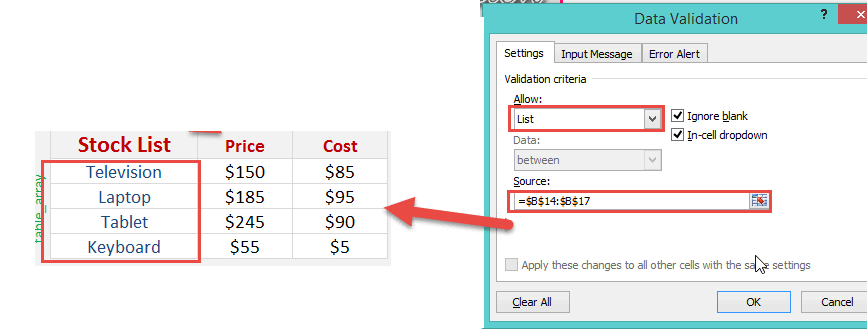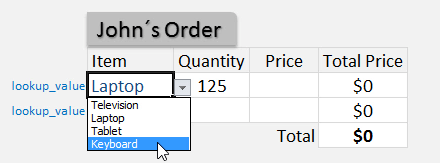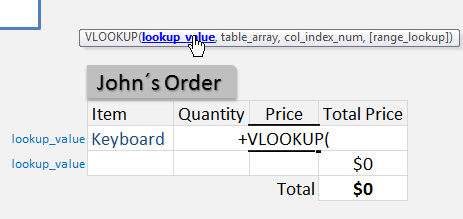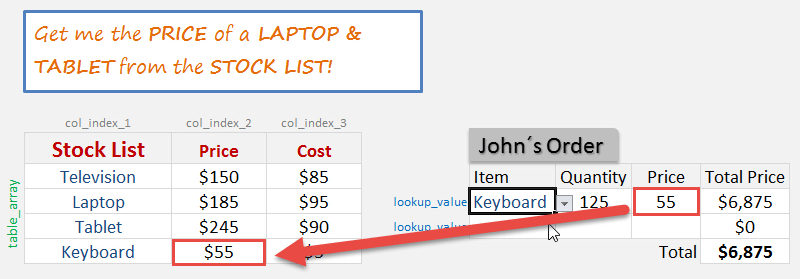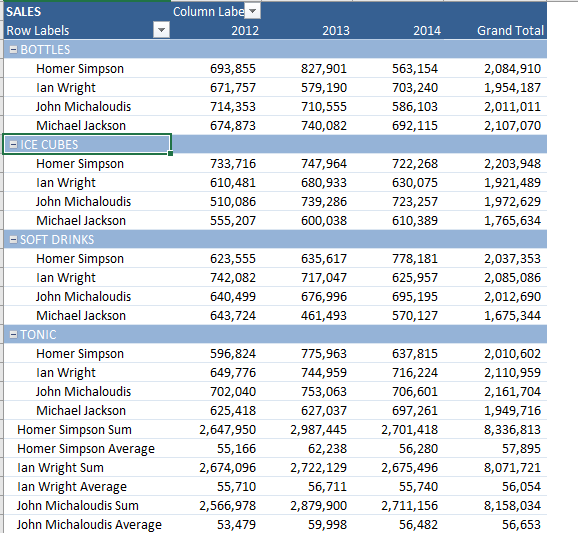The VLOOKUP function in Excel can become interactive and more powerful when applying a Data Validation (drop down menu/list) as the Lookup_Value. So as you change your selection from the drop-down list, the Excel VLOOKUP value also changes.
Key Takeaways:
- VLOOKUP can be effectively integrated with a drop-down list in Excel to retrieve specific data such as prices based on user selection.
- Creating a dynamic drop-down list in Excel requires the use of the Data Validation feature, which provides the user with a list of choices from a defined table. Post selection, other cell attributes like price or description can be automatically filled using VLOOKUP based on the named reference of the chosen item.
Table of Contents
VLOOKUP Formula Syntax
What does it do?
Searches for a value in the first column of a table array and returns a value in the same row from another column (to the right) in the table array.
Formula breakdown:
=VLOOKUP(lookup_value, table_array, col_index_num, [range_lookup])
What it means:
=VLOOKUP(this value, in this list, and get me value in this column, Exact Match/FALSE/0])
Follow the step-by-step tutorial on Excel dependent drop down list Vlookup and download this Excel workbook to practice along
Vlookup with a Drop Down List Step-By-Step Guide
STEP 1: Go to Data > Data Validation.
STEP 2: Select List in the Allow dropdown.
For the Source, ensure that it has the 4 Stock List values selected. Click OK.
Your dropdown is ready.
STEP 3: We need to enter the Vlookup function in the Excel Vlookup example:
=VLOOKUP(
The Vlookup arguments:
lookup_value
What are we looking for?
Reference the cell that contains the text or value:
=VLOOKUP(G15,
table_array
From which list are we doing a lookup on?
Place in the cell range of the Stock List:
=VLOOKUP(G15, $B$14:$D$17,
col_index_num
From which column do we want to retrieve the value?
We want to retrieve the Price which is the SECOND column from our table array:
=VLOOKUP(G15, $B$14:$D$17, 2,
[range_lookup]
Do we want an exact match?
Place in FALSE to signify that we want an exact match:
=VLOOKUP(G15, $B$14:$D$17, 2, FALSE)
The price now dynamically changes based on your selection:
Advanced VLOOKUP Tricks
Handling #N/A Errors Gracefully
When you’re deep-diving into Excel’s potential, you might come across the #N/A error in your VLOOKUP functions. This generally means that the function was unable to find a match for your lookup value. But fear not, Excel gives you the means to handle these errors with grace. Using the IFERROR function, you can designate a default value or action to take place when VLOOKUP can’t find a match. It looks something like this: =IFERROR(VLOOKUP(lookup_value, table_array, col_index_num, [range_lookup]), "Value not found"). This way, instead of an unsightly error, you can offer a friendly or informative message, or even instruct it to perform another calculation.
Dynamically Updating Drop Down Lists Using VLOOKUP
Creating a drop down list that updates dynamically with VLOOKUP adds a layer of flexibility to your spreadsheets, allowing you to choose values that change based on another cell’s input. This dynamic duo comes in handy when you have related data fields. For instance, when you select a certain item from a primary drop down list, the secondary drop down list adjusts to show only the relevant options.
To achieve this, you’ll use a combination of data validation, the INDIRECT function, and named ranges that correspond with your VLOOKUP results. You’ll be forming cascading or dependent drop down lists, where the selection in one dictates the choices in another. It’s a bit tricky to set up, but once done, it significantly improves data accuracy and user experience.
Remember, any changes in your primary data will reflect automatically in the drop down options, keeping everything up-to-date with minimal effort.
Practical Examples to Enhance Your Skills
VLOOKUP and Drop Down List for Inventory Management
Managing inventory can be streamlined effectively using a VLOOKUP and drop down list combination in Excel. You can keep track of item names, stock levels, prices, and descriptions in a well-organized table. When you select an item from a drop-down list, the VLOOKUP function jumps into action, pulling relevant data like its price and stock quantity into adjacent cells. It’s perfect for quick assessments and updates to your inventory records.
Here’s how it can help you:
- Instantly retrieve item information without manually searching through rows.
- Reduce human error, since you are pulling data directly from a table.
- Update inventory details swiftly, simply by changing the source table.
By integrating these Excel tricks, you’ll have a powerful tool to keep your stock levels consistent and accurate, save time, and make inventory management a breeze.
Sales Reports and Performance Tracking Made Easy
When it comes to sales reports and performance tracking, VLOOKUP, combined with a drop down list, helps you create a dynamic reporting tool. You can easily track sales by product, region, or salesperson with a quick selection from a drop down list. VLOOKUP retrieves the relevant sales data, presenting you with up-to-the-minute reports. You can track performance trends over time, compare sales across different categories, or calculate commissions based on sales data—all without writing cumbersome formulas for each query.
Here’s why using VLOOKUP like this is a game-changer:
- Quickly adapt reports to display information that’s relevant to specific audience or time period.
- Minimize the need for manual updates—when source data is refreshed, so are your report summaries.
- Enable easy information sharing among team members who can select different parameters to view custom reports.
This approach ensures your sales reports are always ready for that last-minute meeting, with accurate data just a few clicks away.
FAQ
Why is my VLOOKUP returning #N/A when using it with a drop down list?
Your VLOOKUP could be returning a #N/A for a few reasons. First off, double-check if the value you’re trying to look up actually exists in your data range. It’s also important to ensure that the drop down list matches the data format (text or number) of the lookup range. Another common issue is the lookup range may not include the correct table array or the reference is not set to the proper column index number. By carefully verifying these elements, you should be able to resolve the #N/A error and get your VLOOKUP working smoothly with your drop down list.
Can I use VLOOKUP to populate multiple columns based on a drop down selection?
Absolutely! You can use VLOOKUP to populate multiple columns based on a single drop down selection. You’ll just need to replicate the VLOOKUP formula across the columns you want to populate, altering the column index number (the third argument in VLOOKUP) to match the data you wish to retrieve from different columns. This way, when you select an item from your drop down list, adjacent cells are automatically filled with corresponding information from your data table, streamlining data retrieval and display with efficiency and accuracy.
John Michaloudis is a former accountant and finance analyst at General Electric, a Microsoft MVP since 2020, an Amazon #1 bestselling author of 4 Microsoft Excel books and teacher of Microsoft Excel & Office over at his flagship MyExcelOnline Academy Online Course.


